Dominica is a place where green rainforests meet blue oceans. It’s a food lover’s dream, blending earthy ingredients with fresh sea catches. Each dish tells you a story of heritage and place, making it a top spot for culinary travel.
Your first morning in Roseau begins as you follow the rich aroma of callaloo through the bustling market. You quickly learn how Dominica’s unique climate nurtures wild ginger and coffee. With every step, you see how the island’s land and sea shape each dish, mirroring its natural rhythms and abundant gifts.
Dominican cuisine is all about being true to its roots. You’ll find smoked fish and breadfruit, all made with care for tradition and the environment. This mix of old and new makes Dominica a top choice for food lovers who care about the planet.
Here, you can enjoy coconut stews under the rainforest or follow spice trails with local chefs. The island invites you to taste its heart. Ready to start your culinary adventure? Contact our team at Epicurean Escape for unforgettable Dominican cuisine experiences.
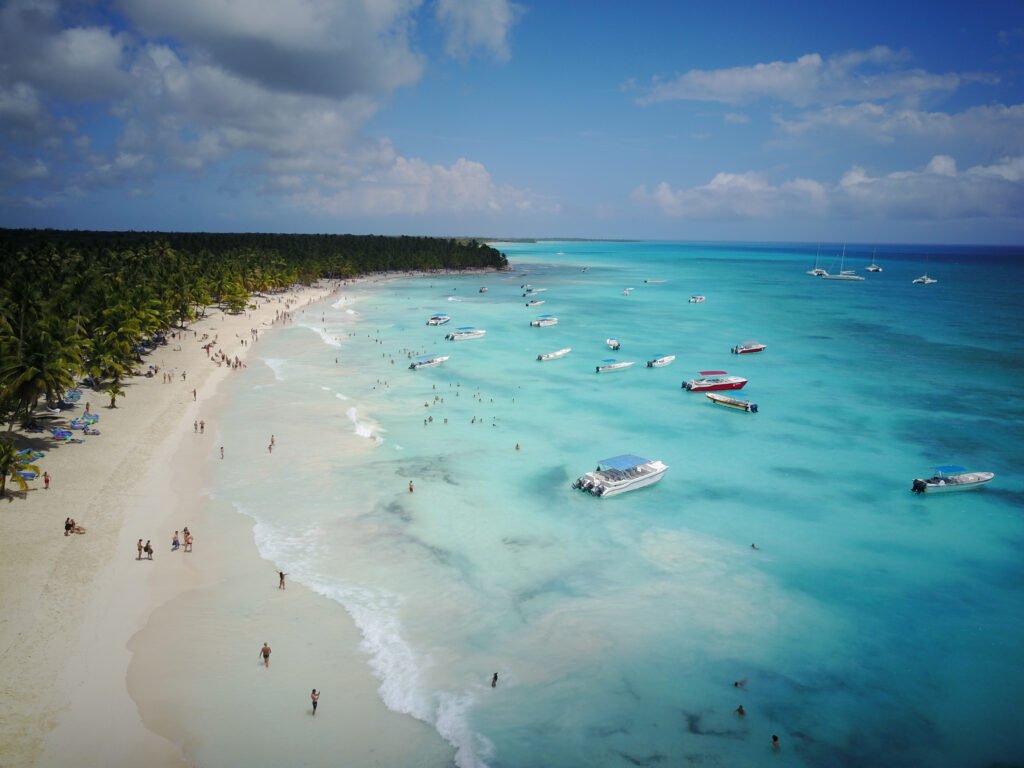
Key Takeaways
- Volcanic soil and coastal ecosystems shape Dominica’s hyper-local ingredients
- Kalinago, French, and African influences merge in signature dishes like mountain chicken and callaloo
- Rainforest herbs and ocean-to-table seafood define the island’s culinary identity
- Sustainable practices are woven into every aspect of Nature Island dining
- From farm tours to riverside feasts, this destination redefines epicurean exploration
Understanding Dominica Unique Culinary Heritage
As you walk through Dominica’s villages, you taste the mix of cultures in every dish. The island’s food history is a mix of Indigenous, colonial, and African influences. Each flavor you savor tells a story of survival, adaptation, and celebration.
| Influence | Key Elements | Modern Dishes |
|---|---|---|
| Indigenous Kalinago | Cassava, river fish, clay pots | Tete batik, wapiso |
| Colonial | Spices, European techniques | Colombo, saltfish |
| African/Creole | One-pot meals, okra-based stews | Protege, accras de morue |
“The earth and ocean are our first chefs,” a Kalinago elder once said while making cassava bread. Their food history goes back thousands of years, using root veggies and smoked fish. These are still favorites today. Spices from the colonial era, like nutmeg and cloves, mixed with local ingredients, creating dishes like Creole cooking classics.
African influences are seen in hearty one-pot meals. These dishes show the people’s resourcefulness and resilience.
Today, chefs keep these traditions alive while adding their own twist. At Roseau’s markets, you can try callaloo stewed with okra. This dish combines African and Kalinago cooking methods. To experience this rich heritage, explore guided tastings that take you from the forest to your plate.
The Rainforest’s Bounty: Native Ingredients That Define Dominican Cooking
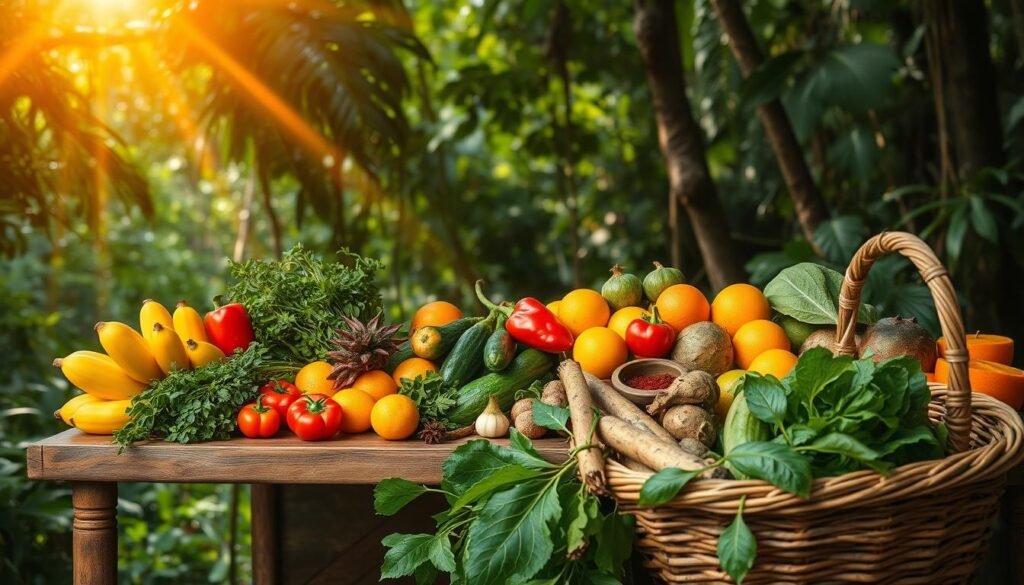
As you explore Dominica’s green forests, you find out how local ingredients make every dish special. Breadfruit, soft when roasted, is a key part of many meals. Dasheen’s roots and leaves are used in callaloo stew, a dish loved for generations.
These plants are more than food; they’re part of the island’s culture.
Your guide shows you wild herbs like bwa bandé and mountain thyme. Bwa bandé has a peppery smell, while mountain thyme tastes like flowers. These herbs add flavor to stews and teas, revealing the rainforest’s secrets.
- Exotic fruits like soursop make refreshing drinks smooth
- Guava’s sweet smell tells you when it’s ripe, and its sweetness is great in jams
- Slender Dominica bananas turn pink when they’re ready to pick
| Ingredient | Flavor Profile | Culinary Role |
|---|---|---|
| Breadfruit | Creamy, subtly sweet | Roasted, fried, or mashed into side dishes |
| Dasheen | Nutty, fibrous | Root used in soups; leaves make callaloo’s base |
| Soursop | Vanilla-tinged acidity | Blended into chilled juices or desserts |
These plants grow well without harmful chemicals. They thrive in a climate where rain and sun work together. Eating breadfruit or guava syrup is like tasting the forest itself. It’s a connection as strong as the island’s volcanic soil.
From Ocean to Table: Seafood Specialties of the Nature Island
As you walk through the docks of Roseau at dawn, you catch the smell of seafood Dominica in the air. The island’s kitchens turn this fresh catch into amazing Caribbean dishes. At a shack near Berekua, you spot a seaside shack where snapper stew simmers—rich with scotch bonnet peppers and creamy coconut milk.
A good catch respects the ocean tomorrow as much as today,” said one fisherman adjusting his net. “We fish to live, not live to fish.”
Fishing here is done in a way that’s good for the ocean. Fishermen use handlines, not big trawlers, to protect the reefs. At Portsmouth’s market, vendors arrange mahi-mahi fillets with care, showing the beauty of eating fresh.
Your favorite meal might just be at Ti Bwa Kanari, where grilled flying fish comes perfectly paired with sweet plantains. Along the coast, shacks like La Tante’s serve up Colima snapper smoked over fragrant pimento wood. And at the cliffside restaurants in Scott’s Head, you’ll find fresh spiny lobster turned into zesty ceviche. Each of these spots reflects Dominica’s deep passion for unforgettable flavor.
- Must-try dishes: Salted cod fritters, grilled conch salad, and curried octopus
- Seasonal highlights: Spot prawns in March, spiny lobster in November
- Market tip: Arrive early at Calibishie’s market for the day’s first catch
Every bite here is a promise to the sea. At Mahaut Restaurant, a whole red snapper was served, its skin crispy from the fire. The menu changes every day, reflecting the ocean’s bounty. This is how Dominica’s seafood culture lives on, not just as a resource, but as a cherished tradition.
Essential Dominica Dishes Every Culinary Travel Enthusiast Must Try
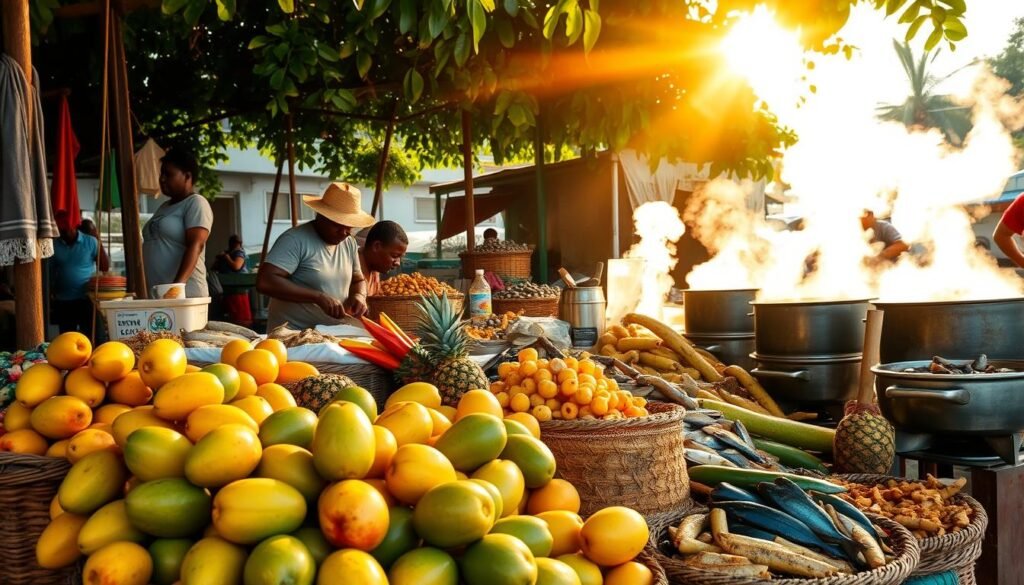
As you explore Dominica’s kitchens, you find dishes that show the island’s heart. From the rainforest to coastal markets, these flavors are what make Dominica unique. Mountain Chicken is a tale of culture and nature. It was once a big feast, now it’s a symbol of heritage, remembered but not eaten today.
But its memory lives on in every kitchen, where tradition speaks through every dish.
Mountain Chicken: The Controversial Delicacy
Its name hides its true nature—a frog almost wiped out. Chefs now celebrate it through stories, not on plates. In Morne Diablotins, guides tell its tale and guide diners to jerk-seasoned meats that share its bold taste.
Callaloo: Dominica Hearty Green Soup
This soup mixes dasheen leaves with coconut milk and scotch bonnet heat. It’s a mix of rough and smooth. Every spoonful shows the island’s taste, best enjoyed at Roseau’s open-air kitchens.
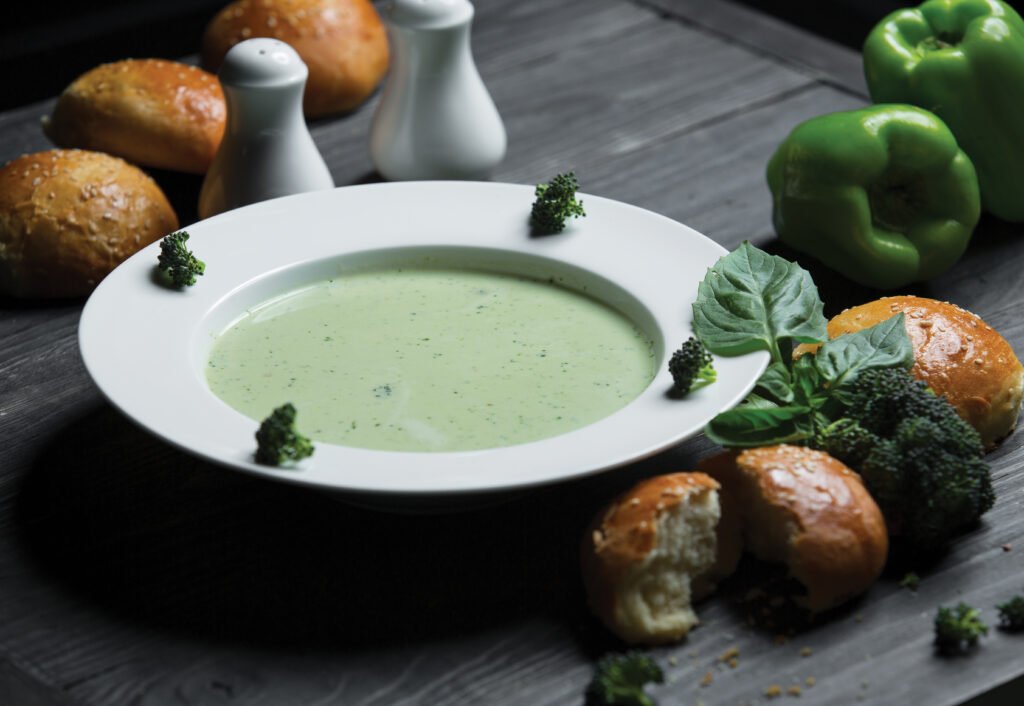
Titiwi: Tiny River Fish with Big Flavor
Caught under the moon, these fish become crispy fried treats. Their taste is unique, found only at Layou’s riverside stalls.
- Rice and peas, simmered with coconut milk, vary by village
- Yam and breadfruit are staples, showing the traditional Caribbean dishes spirit
- Pastries like jourou pies show French touches in the island cuisine‘s history
Look for family-run authentic recipes shared through stories. These dishes are more than food—they’re talks with Dominica’s history.
The Art of Roadside Dining: Street Food Adventures in Dominica
Your first taste of Dominican street food might come on a bright afternoon. when the scent of a charcoal grill pulls you toward at a family-run food stall. Here, roadside vendors serve more than just food—they offer you a true taste of the island’s soul. You hear the sizzle of palm oil frying, catch the smoky aroma of grilled corn coated in bold spices, and realize every bite carries the spirit of Dominica.
The must-try dish is the bake. It’s a golden dough pocket filled with saltfish or smoked herring. Vendors make them fast, their hands moving like clockwork. Nearby, corn is roasted, its kernels buttery and spicy.
On weekends, parking lots become roadside vendors spots. Families grill pork ribs and chicken over pits. The sauces are magical, ranging from sweet to scorching. Adventurous eaters look for accras (golden fish fritters) or souse, a tangy pork dish.
Pro tips:
- Look for crowds: locals know the best stalls
- Always ask for “seasoning” (Dominica’s term for hot sauce)
- Prices are modest—$3-5 USD for most dishes
These eateries are more than just places to eat. They’re where travelers and vendors share stories. A smile and a “Bonjou” (good morning, in Creole) mean more than money. The island’s heart beats strongest where smoke meets roadside vendors, making every meal a shared tale.
| Dish | Flavor Profile | Where to Find |
|---|---|---|
| Bakes | Crisp shell with savory fillings | Along the highway near Portsmouth |
| Roast Kross | Buttery sweetness with chili kick | Weekday stops near river crossings |
| Barbecue | Smoky meats with tangy sauces | Weekend gatherings in Roseau |
| Accras | Crispy batter enclosing spiced fish | Early morning market stalls |
Farm-to-Table Experiences: Agricultural Tours and Cooking Classes
As you walk through sun-dappled rows of taro and dasheen, you learn how Dominica’s farmers merge ancestral wisdom with modern organic practices. Farm-to table Caribbean isn’t just a trend here—it’s a way of life rooted in the island’s volcanic soil and misty slopes. These experiences turn travelers into active participants, tasting the earth’s flavors firsthand.
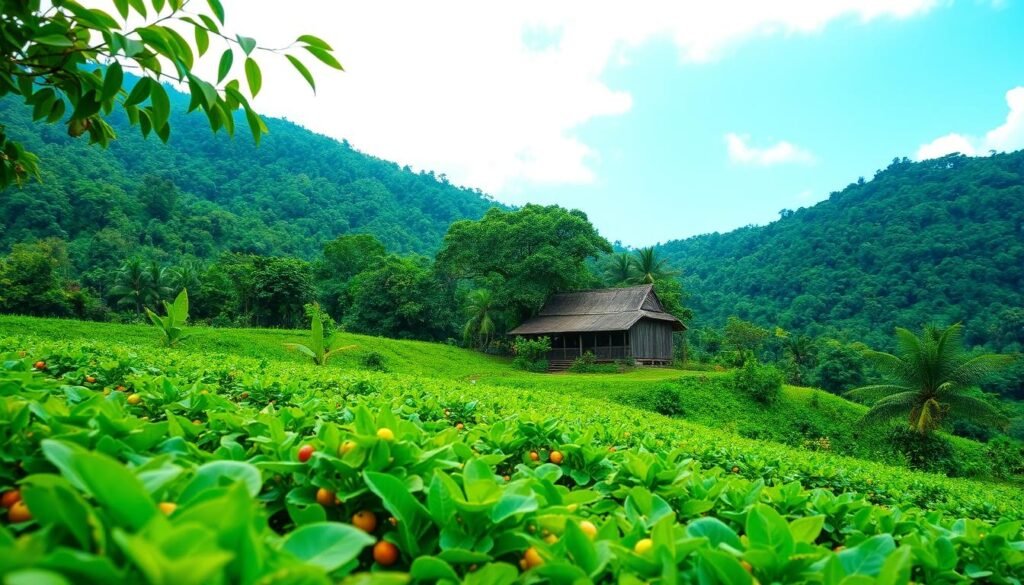
Organic Farm Tours in the Island’s Interior
At River’s Edge Permaculture, you follow a farmer through terraced plots where spices like zest and culantro thrive. “Every leaf here tells a story,” she says,
“the soil remembers what we give it.”
These tours reveal how organic farming sustains ecosystems while feeding communities, with hands-on tasks like harvesting coffee cherries or tasting wild honey straight from hives.
Hands-On Cooking Workshops with Local Chefs
Cooking classes Dominica blur tradition and technique. In a bamboo-shaded kitchen, you learn to balance the bitterness of callaloo greens with the richness of coconut milk under the guidance of Chef Édith Joseph. Later, in a village kitchen, you watch matriarch Marie Pierre shape fungi bread dough—a hands-on lesson in trusting “feel over measurement”. Whether it’s a quick two-hour demo or an immersive multi-day retreat, these workshops give you the tools to carry Dominica’s bold flavors home with you.
Chocolate Making from Dominican Cacao
Your journey into Dominican chocolate begins in the island’s shaded cacao groves, where pods burst with ruby-colored pulp. At Wobton Chocolate, you roast beans over open fires and discover how Dominican chocolate develops its signature smoky-sweet profile. The experience ends with tasting bars infused with local island spices—a delicious finale to your hands-on introduction to this growing craft.
Whether you’re tracing cocoa’s journey or kneading dough alongside seasoned hands, these experiences turn you into a true custodian of Dominica’s flavors. You can book them easily through local agrotourism platforms, with most workshops ranging from $60–150 USD and lasting anywhere from 2 to 5 hours.
Dominica’s Vibrant Market Culture: Roseau and Beyond
Food markets in Dominica are more than places to shop. They are where the island’s spirit comes alive. At the Roseau market in the morning, you’ll see a world of colors. Fresh produce shines, and local vendors welcome everyone with smiles.
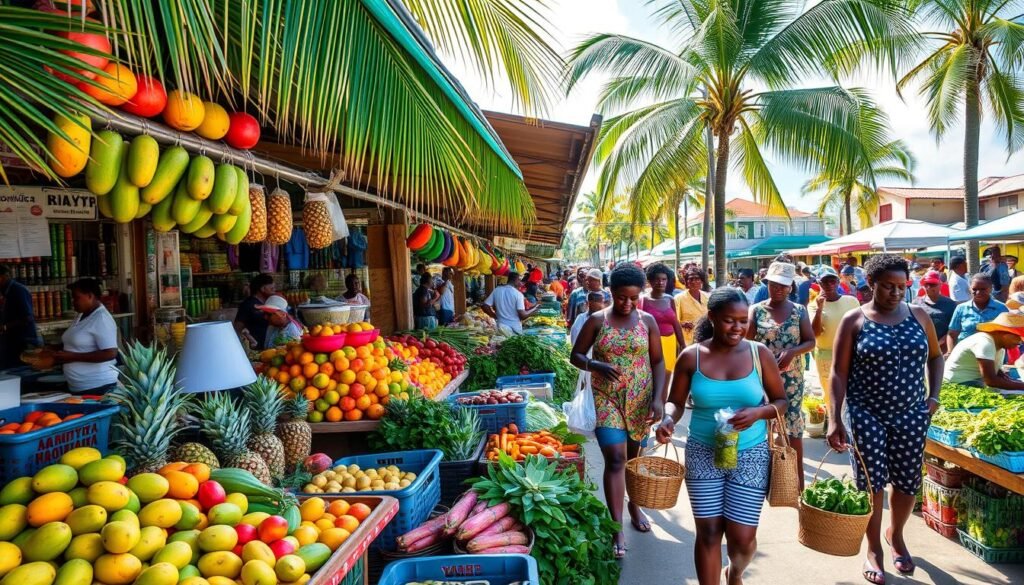
Start your journey at the Roseau Market, the heart of Dominica. Get there by 7 AM to see the fresh produce. Mangoes and christophines are just the beginning. Pro tip: A ripe passionfruit is heavy.
Don’t be shy to ask prices. A simple “Kwey?” (meaning “How much?” in Kwéyòl) can lead to great deals.
Then, head to Portsmouth’s Saturday market. It’s a more relaxed scene by the river. Here, you’ll find herbs like culantro and scotch bonnet peppers from the north.
Seasonal Produce Calendar
| Season | Must-Try Produce |
|---|---|
| June–August | Mangoes, breadfruit, guavas |
| September–November | Christophines, dasheen, tamarind |
| December–May | Papayas, star apples, soursop |
Don’t forget to try new things. Enjoy coconut water or “bakes” from street vendors. These markets are where Dominica’s tales are told through food.
Liquid Gold: Rum Distilleries and Herbal Beverages of Dominica
Your journey into Dominica’s liquid heritage begins at Belfast Plantation, where the air is rich with the scent of fermenting sugarcane. Here, you watch Dominican rum crafted in copper stills, each pour revealing deep notes of vanilla and earth—flavors that speak of tradition and time.
The distillery’s machinery echoes the island’s history. It turns tropical abundance into golden elixirs.
Outside the distilleries, bush rum shows local ingenuity. It’s made by mixing white rum with herbs like lemongrass and ginger. These homemade infusions are more than drinks—they’re remedies and rituals.
A local brewer says, “Every bottle holds a recipe passed through generations.”
| Beverage | Flavor Profile | Cultural Role |
|---|---|---|
| Dominican rum | Smokey, sugarcane-forward | Symbols of colonial and post-colonial resilience |
| Bush rum | Herbal, citrus-infused | Medicinal and celebratory traditions |
| Mauby | Bitter-sweet tree bark brew | Healing tonics from the rainforest |
| Sorrel | Sharp, floral, served with spices | Festive symbol of harvest and renewal |
Even non-alcoholic traditional beverages are captivating. Cocoa tea is a velvety morning ritual, paired with breakfast. Herbal drinks like sorrel bloom in glasses during Christmas.
These liquids are savored as part of Dominica’s living culture. Try a bush rum blend or a hibiscus-infused sorrel. You’ll taste centuries of adaptation and pride.
Where Rainforest Meets Ocean: Waterfront Dining Destinations
Imagine enjoying a meal as the sky turns into shades of amber and violet. Dominica’s coastal dining spots offer meals that blend flavors with the island’s stunning landscapes. My search for the perfect sunset dinners revealed places where the ocean and wilderness are part of every dish.
Sunset Dining on the Caribbean Shore
The Caribbean coast’s calm waters are home to waterfront restaurants where sea air meets garlic-scented seafood. Near Scotts Head, a cliffside restaurant lets you watch the sun set over the sea. Lobster tails sizzle with butter and herbs.
These spots often fill up fast—book early for the best sunset views.
Atlantic Treasures: Wavefront Secrets
On the wild Atlantic side, family-run coastal dining spots serve fresh fish. Near Berekua, a hidden gem offers grilled kingfish with coconut chutney, just steps from the waves. For a more refined experience, La Tropicale combines local flavors with modern presentation.
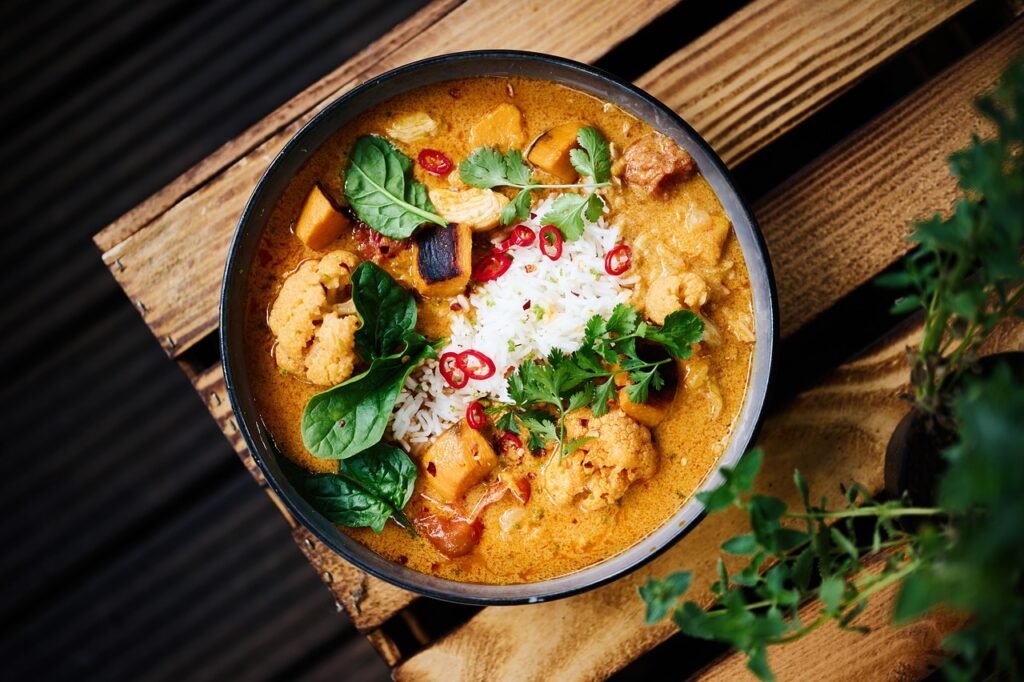
- Reserve coastal dining tables 2-3 days in advance for peak season
- Ask locals for “tide-friendly” ocean view eateries; some spots are only accessible at low tide
Every bite here is infused with the essence of the place. The salty breeze and the play of light on the waves make dining here an unforgettable experience.
Sustainable Gastronomy: How Dominica’s Eco-Focus Shapes Its Food Scene
As you walk past a roadside stall in Morne Bruce, you watch a vendor carefully fold plantains into banana leaves, turning eco-friendly dining into an art form. In Dominica, sustainable food tourism isn’t just a trend—it’s a way of life.
Chefs here create menus that reflect the island’s dedication to environmental conservation. They source ingredients within a five-mile radius. A chef in Scott’s Head shows you how organic island cuisine works: herbs from a kitchen garden, yams without pesticides, and fish caught with reef-safe nets.
Places like Le Printaniere Rainforest Retreat live this philosophy. They serve dishes like callaloo made from leaves foraged daily. Their zero-waste approach includes composting scraps into soil for their garden.
Even plastic straws are replaced with coconut husks. This shows that sustainability can be both elegant and practical.
“When ingredients travel less, their flavors stay truer.” – Chef Jacques, Roseau’s Eco-Café
Government programs now require farms to grow hurricane-resistant crops like dasheen. This ensures dishes are made without depleting resources. Visitors can taste this resilience in every bite of grilled mahi-mahi or coconut-wrapped breadfruit.
Choosing these eco-friendly dining spots is more than a choice—it’s a vote for preserving Dominica’s landscapes. The result? A cuisine that’s not only good for the earth but also full of the raw flavors of untouched soil and sea.
Conclusion: Creating Your Personal Culinary Itinerary in the Nature Island
Planning a culinary trip to Dominica is all about finding the right mix of planning and spontaneity. Whether you’re a food lover or just curious, your gastronomic itinerary should capture the island’s unique blend of rainforest and ocean. Begin by deciding what you want: a deep dive into local culture or a casual food tour. Book key experiences like Organic Farm Tours or chocolate-making workshops first. Then, leave room for unexpected finds, like a roadside Mountain Chicken stand or a riverside lunch.
For those who love to get their hands dirty, Dominica offers plenty of opportunities. You can learn to make callaloo or follow the journey of a cocoa bean to chocolate. For a more relaxed experience, enjoy fresh titiwi fish, coastal seafood feasts, or a rum tasting at Waitukubuli National Park. Make sure to pair your meals with the stunning views around you, like a breakfast hike followed by brunch or a sunset dinner by the sea.
Let Dominica’s natural rhythm guide your trip. Visit the Roseau Market early for the freshest produce, and book cooking classes well in advance. But also leave afternoons free for exploring—Dominica’s hidden treasures often pop up unexpectedly. Each meal is a doorway to stories of resilience and creativity, from Kalinago traditions to sustainable fishing.
Start with the essentials: a river fish lunch, a swim in a volcanic spring followed by cacao coffee, or a beachside dinner at twilight. These moments, filled with respect for the land and people, turn you from a visitor into a true participant. Dominica’s food culture thrives on those who take their time, listen, and stay awhile. Your gastronomic itinerary should reflect this: slow, thoughtful, and fully engaged. The island’s flavors are best enjoyed one mindful bite at a time.


